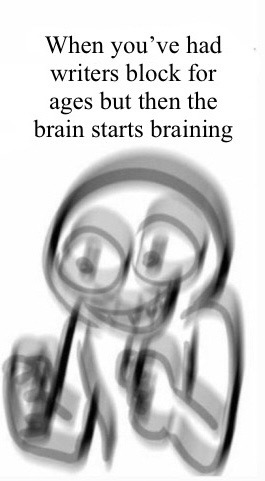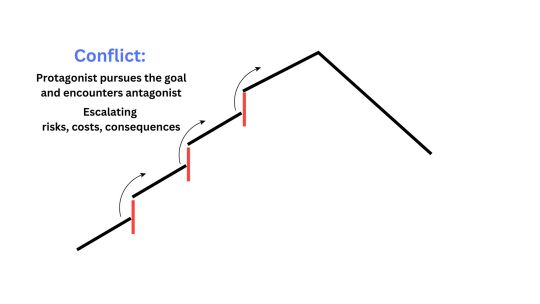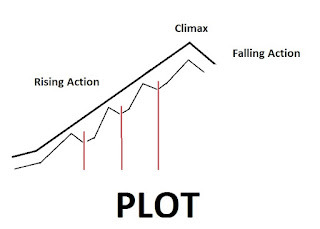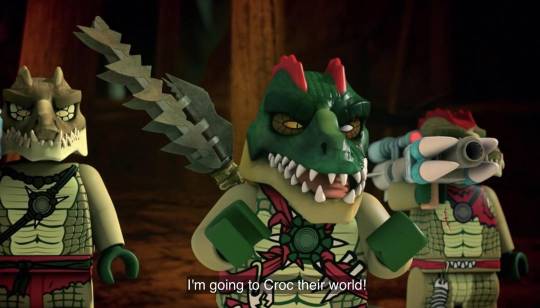#writeblogging
Note
Not sure if you've seen it on twitter, but someone drew some lovely fanart for the latest chapter of Of Rage and Love https://twitter.com/KokoaDestroyer/status/1780242004783534362?t=ikcPlzOFGBtGRIkhLc73dQ&s=19

ABSOLUTELY BASED AND DRAGONPILLED TY OP!
#writeblogging#the games of divinity#he's so wet and sad but is also ready to start eating people again
24 notes
·
View notes
Text

Keyboard go BRRRRRRRRRR
#writing#creative writing#writer#writers#writeblr#writeblogging#writer problems#writer memes#writing problems#writing memes#writeblr memes
17K notes
·
View notes
Text
do you ever not write for so long that you’re almost afraid to? like what if I’m dumb now
#what if I’ve forgotten how#better procrastinate and make it worse!!#writeblogging#writer’s block#writeblr#writers on tumblr#writing memes#ao3 memes#fanfic memes#ao3#fanfic#evie’s jeevies
68K notes
·
View notes
Text
“how’s the writing going?” i’m glad you asked! my room has never been cleaner and i’ve decided to take up baking
93K notes
·
View notes
Text
"I should write" *looks at memes about writers procrastinating writing instead*
#writeblogging#ao3 writer#writeblr#fanfic writing#writing community#writing#fanfiction writer#writer stuff#creative writing#writers of tumblr#writers on tumblr#writing humor#writing memes
4K notes
·
View notes
Text
"i think i should be able to fit all this in one chapter" - writer who is going to end up splitting it into three chapters
#original#writeblogging#ficblogging#WHY DOES THIS ALWAYS HAPPEN#anyway the second half of what was supposed to be chapter ten of karen from hr has to split again#if y'all want the awkward sex anyway#the awkward sex needs to be its own thing
795 notes
·
View notes
Text
How to make your Readers Feel Emotions for Dummies
(AWWWWW :]]]] Edition)
So... Do you have any cute animals or children in your story?
No?
Then I can't help you go away
Kidding, kidding, you can make AWW moments in your story no matter who or what your characters are.
First
You have to have at least semi-Likable characters (Pets, adorable animals, or children make this wayyyyyy easier)
Likable characters make your readers want the characters to be happy! You can't really get AWWWW moments if you want the characters to suffer
Most AWWW moments come from Shipping or cute baby moments
Second
Decide what Type
whether you want it to be an AWWWW Romance moment, or an AWWWWW Baby moment
There's also #3 I forgot to mention: AWWWWW comfort/sentimental moment
Third
Decide which character the AWWW moment will happen between
Couple, Father/child, mother/child, friends, siblings, doesn't matter - Well... it obviously matters Which AWWW moment you're going for but... yeah
Fourth
What's Gonna happen?
For romance it's usually cute fluff moments - Want examples? Too bad, look it up on Pinterest! No, no, Joking. Here's a list:
Small cheek/hand kisses
A small, 'I love you so much.'
Wearing other's clothes
Forehead touch
Cuddling
Holding BOTH of each other's hands
FACE TOUCHES - Cheek/jawbone is best
Leaning into touch
Careful dancing
For parental figure and Child it's usually a comforting trust moment, a protecting the child moment, or a 'make me proud' moments
I fucking love these and I'm gonna go on a rant Addict, Tired, bitter mentors are so fucking great. There's so much you can do with them Mostly there's 'make me proud moments' The first 'I approve' moment There's 'you've made me proud' moments There's also 'Fine, you're my kid' moments And comforting trust moments hit so much harder when the mentor rarely shows affection.
It's just so... :D
For Friends, You should do with comforting moments, or a 'you don't know how much I care about you moments
Fifth
Soft Phrasing = soft emotions
Use long, calm sentences. No exclamation points or question marks unless it's dialogue. Keep everything smooth and fluid.
Tears are a powerful tool so use them sparingly
Use short words, and use cuter, softer words, metaphors, and adjectives.
Sixth
Have a visible result
Smiles, cute thoughts, cute dialogue, different feelings or actions towards other characters
Stuff like that
AWWWWW moments can be very powerful to characters as they can for real people, they can change so much with little words.
They can be turning points, displays of affection to the audience, turning points of affection, showcases of change, strengthening of relationships, a final goodbye, they can be so much in just so little.
Good Evening and Good Luck with your Writing My loveable Writing friends! you can do this! <3
#creative writing#fiction writing#writing community#writer things#writerscommunity#writers on tumblr#writeblr#writing#writers#writer#write#writers and poets#writblr#author#writeblogging#writebrl#write better#writing tips and tricks#writing tips#writing advice#writing help#writing characters#writing resources#writing guide#authors of tumblr#writerscorner#novel writing#indie author#writing a novel#writing about writing
151 notes
·
View notes
Text
How to Convert Exposition into Ammunition

Exposition is all the facts and information conveyed to the audience. It's facts about the setting, the worldbuilding, the characters, the current situation, the history, the magic or technology, or anything else that is straight-up information. Every story needs some exposition, but for all of us, it's been tricky to handle at one point or another.
One of the quickest ways to tell a beginning writer from an experienced writer, is how he or she handles exposition. Beginners often cram in too much too fast, leading to poor pacing, info-dumps, or maid-and-butler dialogue. Professional writers know how to expertly weave exposition into the story, so that the audience is fed information without hardly noticing it.
Last year, I did a post on how to use turning points to help you discern what info to put in and what info to leave out, when. I mentioned that in his famous book, Story, Robert McKee has a maxim: "Convert exposition into ammunition."
It sounds great, right?
But like some of the most meaningful writing advice, it can be difficult to wrap your head around.
It sounds great, but like . . . how does one actually do that? And what does that actually mean?
Luckily, McKee does expound a bit on what he means, and today I'd like to expound on what he means by offering my own spin on it.
As McKee points out, "Show, don't tell" is key for exposition--we want to find ways to dramatize the information. Okay, great, chances are if you're reading my blog, you already know that. Still, it's often helpful to start with what you know.
McKee writes:
Dramatized exposition serves two ends: Its primary purpose is to further the immediate conflict. Its secondary purpose is to convey information. The anxious novice reverses that order, putting expositional duty ahead of dramatic necessity.
This is the part I want to emphasize: Its primary purpose is to further the immediate conflict.
Summed up into one simple line, this is what it means to turn exposition into ammunition.
But don't worry, I won't leave you with only that.
Cause if you know me, I like to go deep . . .
Load the Ammunition! Exposition as an Asset or Problem
Ammunition is meant to be shot, dropped, or detonated.
It's not something you use during peaceful circumstances (unless, of course, the peaceful circumstance is just covering up a silent struggle).
Because we want to connect the exposition to the current conflict, this means that one of two (or both) battling forces is loaded with the ammunition.
The protagonist.
Or the antagonist.
And when I say "antagonist," I'm not just talking about the main "bad guy."
The antagonistic force is whatever is opposing the protagonist in the pursuit of his goal. So while there is often a main antagonist, there will actually be lots and lots and lots of lesser antagonists. A rock may be an antagonist. A computer. A storm. A substance. A mouse. (Read more about this in "The True Purpose of Antagonists.")
Furthermore, the protagonist of a scene may not always be the main protagonist of the story (but more on that in a sec).
The protagonist is someone the audience is oriented toward (often the viewpoint character), who is pursuing a goal.
So, to simplify, the protagonist pursues a goal, and the antagonistic force opposes that.
This is what creates true conflict, which may or may not include flying fists or shouting matches. Conflict is simply the protagonist struggling to pursue the goal because of the antagonist.
When the protagonist is loaded with ammunition, it's an asset. He aims it at the antagonist to get the obstacle out of his way.
When the antagonist is loaded with ammunition, it's a problem. He (or it) aims it at the protagonist to get the protagonist out of the way.
This means that in order to make exposition into ammunition, we need to turn the information into an asset or a problem.
And it needs to become an asset or a problem for the current conflict. . . .
The Current Conflict
Okay, so, before we go much further, I need to briefly review a few concepts. If you've been following me a long time, I hope you won't want to aim your ammunition toward me, because we've gone over this a lot, but it's critical to make sure we are all on the same page, because everything builds off the basics.
Novelists often focus on the big main conflict that stretches through the length of the book, the global story or the narrative arc (depending on what terminology you prefer), and structurally, it looks like this:

The conflict creates the rising action. If we were to zoom in, it'd be like this . . .

But this isn't only true of the story as a whole. Story structure is a fractal, and this is true of smaller structural units as well.
This is true of acts (and the second act is commonly cut in half):

And it's also true of scenes:

They fit inside each other, like a Russian nesting doll.
This means nearly every scene has a conflict.
This also means that nearly every scene should have a goal.
And nearly every scene should have an antagonist.
Because, rising action only happens when a character is pursuing a goal and running into antagonistic forces (obstacles). This is what creates the climb, the escalation.
The difference is that in a scene, all these components happen to a smaller degree, than the story as a whole.
So, the protagonist and antagonist of a scene, may not always be the same as the main protagonist and main antagonist of the global story.
The primary purpose of exposition is to further the immediate conflict.
The immediate conflict is what's happening in the scene. It's the current scene's conflict.
And yes, often that conflict is also feeding into the act-level conflict, which is feeding into the global story conflict. Because the smaller units fit inside (and even make up) the larger units.
So we best turn exposition into ammunition, by making it ammunition for the current conflict.
For the scene-level conflict.
Let's talk about how to do that. . . .

Exposition as Ammunition
Just as that basic structural shape fits within itself, within scenes, so do all the basic elements of plot.
The primary principles of plot are goal, antagonist, conflict, and consequences (stakes & ramifications).
Every scene should have a goal, an antagonist, a conflict, and consequences.
Turning points are important too--those are the "climaxes" in the structures above--it's when the conflict hits a definitive outcome that changes the direction of the story. It turns it into falling action.
There are more plot elements that build off these, but these are the most important and most foundational. They almost always need to be there to create a great scene.
The way to turn exposition into ammunition, is to turn information into plot elements.
It's part of the goal. It's part of the antagonist. It's part of the conflict. It's part of the consequences. It's part of the turning point. (Or it's part of one of the other plot elements I didn't mention (I'm simplifying).)
Or even more simplistically speaking--it's an asset or a problem in the current situation.
Let's look at an example to demonstrate.
Example #1: Magic System Exposition into Ammunition
Say we have a magic system about shadows. Perhaps in it, if your shadow overlaps with another's, that person is more susceptible to your influence and manipulation. In your little fictive world, you think this is a cool idea, and of course, the audience needs to know about it.
But simply explaining it to the audience isn't plot. Exposition in and of itself, doesn't make plot. Exposition is just information, and it certainly isn't functioning as "ammunition."
How do we convert it into ammunition?
By connecting it to plot.
We make it the protagonist's goal to manipulate another character through her shadow. Now she watches light sources and where her shadow falls. Now she tries to get closer to this other person, without being obvious. It's interesting because it's relevant to what's happening at hand.
Or perhaps in this scene, this magic is part of the antagonistic force. Someone else is trying to stop the protagonist by manipulating her via shadow, and now she needs to make sure their shadows don't touch.
Or we bring the shadow magic into a different, current conflict. Maybe neither person originally intends to manipulate the other via shadow. They are arguing about something totally different. But as it escalates, one shadow falls over the other's and contributes to the situation. It helps the protagonist, or it creates more problems for the protagonist.
Or we tie it to the consequences. If the protagonist fails to outrun the antagonist (current conflict), the antagonist will force her down, then manipulate her to the point she's basically brainwashed via shadow magic.
Or, we make it part of the turning point. The current conflict escalates, and the way the "battle" is definitively lost or won is by manipulating someone via shadow.
It's not just information anymore. It's ammunition.
It's working as an asset or problem for the protagonist.
As the audience watches this play out, they barely recognize they are being fed information.
To them, they are simply being fed plot.
And it's scene-level plot. Meaning, it's immediately relevant.
Suddenly what could have been a boring chunk of info-dump is exhilarating. It has the audience on the edge of their seats.
Let's look at another example.
Example #2: Backstory Exposition into Ammunition
Let's say your character has a history with another character in the scene. They were childhood neighbors, and one time as kids they got into trouble. They were throwing water balloons at passing cars, and one of the drivers got out and chased them. They got cornered in an alley and the driver called the cops.
Now, these characters find themselves together again, and they are planning what to do next on their way toward the main plot goal.
So I could just dump in that backstory as exposition. . . .
Or I could find a way to turn it into ammunition.
Rather than having them peacefully planning together, it would likely be better if they were arguing about what to do next. This makes the second character an antagonist for the protagonist, within the scene.
Each person is trying to convince the other that their idea is great and the other person's is terrible.
As things get heated, the second character blames the protagonist for getting the cops called on them as kids.
This is now ammunition that feeds into the fight--it's the antagonist shooting it against the protagonist in the current conflict.
Now they are arguing about the water balloon incident.
So what was originally just info about their pasts, is now contributing to the current plot.
Let's do one more example . . .
Example #3: Character Exposition into Ammunition
Your character dreams of winning the upcoming beauty pageant. But that information isn't relevant to the current plot. Yet it's important information to know, because it conveys not only her interests but key skills she's going use in an upcoming scene.
You could try to shoehorn it in, or you could weave it into the current conflict.
Perhaps the current conflict is seemingly unrelated.
She has to walk home from work every day, and her goal is to get home before dark. She doesn't feel safe walking home in the dark.
Anything that delays her, becomes an antagonistic force.
She's facing stray dogs, street salesmen, and chatty acquaintances.
In her rush, she accidentally steps into a storm drain grate, which ruins her shoes.
The shoes she intends to wear to the beauty pageant (she shouldn't have worn them that day, but she had a nice presentation at work and took the risk).
This is a cost, or consequence (ramification) of her pursuing her home in a rush.
It's "shot" her in a way that impacts her future. It's thrown her trajectory at least slightly off balance.
It's a problem.

Contextual Exposition
Now, I want to acknowledge that not every single piece of information needs to be completely dramatized or "shown," and if it was, chances are the audience would feel like the story was lacking context.
Context is the information the audience needs to properly interpret the story. Without it, the audience feels a little blind. They need the narrator to guide them so they can appreciate what is unfolding.
So, if Joe calls Mack, "Sam," the audience wants a clue as to why. Is Sam a nickname? Is Joe bad at remembering names? Is Joe doing this to be rude? The audience doesn't know. They can't properly interpret what just happened. They need more insight.
If Joe calls Mack, "Sam," to be rude, then the narrator needs to drop a line of exposition to explain that. This is not only acceptable, but necessary.
In a strange way, though, this kinda brings us full circle.
Notice that this is providing context for the current conflict (or situation).
It's not information for the sake of information.
Having this information adds power to the current scene. It will help us understand that scene's conflict.
It doesn't take away or distract us from that scene.
In the same book, McKee talks about how you must pass on information that ensures the reader won't be confused. This is contextual information.
(Well, ensures the reader won't be unintentionally and unnecessarily confused. (In some rare exceptions, we may want the reader to be confused, but only briefly.))
McKee says, do pass on exposition if it reduces confusion.
Do write contextual exposition.
Even in my magic system example above, I would include contextual information. If I didn't, the audience wouldn't know to care two cents about the protagonist's shadow. They would probably feel confused on some level, when one character suddenly succumbs to the influence of the other, not understanding how or why.
Contextual exposition helps build the framework of the current scene's plot.
It may not be ammunition, but it's the material of the weapon that will hold the ammunition.
If there is no weapon, the ammunition doesn't do so much.
Reveal the information that will make the ammunition most impactful in the story.
When you do that, it's still relevantly tied to the current plot.
#writeblr#writeblogging#writing tips#writing tips and tricks#writing tip#writing help#writing advice#writer#writing#writing reference#writers on tumblr#writerscommunity
187 notes
·
View notes
Text
Hey Writeblr, show us your original project's AO3 tags.* So far for mine, I've got:
Terrible Decisions, PTSD, Bad at Relationships, Seances, Ghosts, Historical Romance, Psychological Horror, Haunted Houses, Artists Behaving Badly
*like if you were going to post your original whatever how would you tag it to let people know what to expect
188 notes
·
View notes
Text
Character who is sun-coded but not in the traditional "ray of sunshine" way. Character who is sun-coded in the sense that they're revered by the masses but their light is blinding, poisonous fire that destroys everything unshielded. In the sense that they force everything into an orbit around them. In the sense that they seduce Icaruses to fly too close to reach their light and be burned, but they don't care. In the sense that for all their fiery blaze, they're destroying themselves with it. In the sense that they run hotter as they grow older, but instead of going out in a blaze of glory that takes everything down with them like they might have wanted to, they just fizzle out and fade away. In the sense the rest of the world will outlive them.
#this is about The Lightbearer - but applicability#writing prompt#writeblogging#writeblr#writing ideas#writing#writers on tumblr#writers and poets#writerscommunity#creative writing#writer stuff#on writing#destructive and corrupting light
159 notes
·
View notes
Text
I am lacking WLW content on my dash -
SO PLEASE REBLOG IF YOU WRITE WLW STORIES. GIVE ME QUEER WOMEN, GIVE ME MORALLY GRAY QUEER WOMEN.
and also like to interact with tag games and the occasional ask game.
bonus if you like genshin impact, oxenfree, night in the woods. omori, or anything similar to those or anime. not required but appreciated okay thank you goodbye
291 notes
·
View notes
Text
"Then I feel, Harry, that I have given away my whole soul to someone who treats it as if it were a flower to put in his coat, a bit of decoration to charm his vanity, an ornament for a summer's day."
-Oscar Wilde, The picture of Dorian Gray
#dark academia#the picture of dorian gray#dorian gray#oscar wilde#oscar wilde quotes#light academia#dark academia aesthetic#writeblogging#academia#litblr#literature#writblr#bookblr#books#homosexuality#gay pride#gay men#lgbtq#lgbtqiia+#homosexual#homoerotic#homoerotism
287 notes
·
View notes
Text


arguing with water; the ship
128 notes
·
View notes
Text
you ever read a fic so good you want to sit around and discuss it with people english class style
#the motifs darling!!#the themes!!#the arcs!!#and if the writer could also be there even better#evie's jeevie's#ao3 memes#fanfiction memes#haikyuu fanfiction#writeblogging#writers on tumblr
50K notes
·
View notes
Text
How to stay focused and write your WIPs
Write sentence. Is it poorly worded? Not now. Does it sound dumb? Don't care. Is it too similar to another sentence in earlier in the work? Ignore it. Can't think of the right word? Just write another one and keep moving.
Treat your first draft like a speed-run. You can go back and edit later, but you can't edit something that doesn't exist.
Write now, details later.
I wrote a whole chapter like this once. Did I cry a little when I went back and read it again and saw how shitty it was? Yes. But at least I had something and I was on Step 2.
Just write.
#writeblr#writer's block#writeblogging#archive of our own#ao3#should be taking my own advice but...#here we are#personal
51 notes
·
View notes
Text
Writeblr Introduction

Please reblog!
Hello Writeblr! I'm oliveScales, and I'm currently writing and illustrating my webcomic named "The Forgotten Legends of Chima", or TFLOC for short.
I'm a fan of mythology and folklore, and I'm trying to study a few of them for my worldbuilding. Worldbuildings with focus on culture are my favorite! I also really like stories with animals and anthropomorphic characters. I'm an american who enjoys studying other cultures, and am currently studying the Portuguese language!
The Forgotten Legends of Chima is a fantasy science fiction story about the land of Chima, home to eight animal tribes. Here, you'll learn about their cultures, witness intriguing and complex relationships between them, and understand the importance of diversity.
TFLOC is an interpretation of Legends of Chima's storyline, which means that worldbuilding and characters are going to be developed alongside new content to add further depth into the story, such as unimportant/secondary characters becoming important and vital to the story.
Synopsis
In a world where civilizations clash for Chi in order to survive, Laval, prince of the Lion Tribe, strives to overcome every war and all injustice without ever gripping a sword. It all started when Laval witnessed evil and inequality with his own eyes. Since then, he has promised himself to protect anyone, no matter who they are, from suffering and that he will restore peace in the land of Chima. These are the Forgotten Legends of Chima.

Chapter 1
Episode 1
Episode 2
Episode 3
Chapter 2
Coming soon :)
Sneak Peeks
TFLOC Full Sneak Peek
TFLOC Episode 2 Sneak Peek
TFLOC Sneak Peek (part 1)
TFLOC Sneak Peek (part 2)
TFLOC Sneak Peek (part 3)
TFLOC Sneak Peek (part 4)
TFLOC Sneak Peek (part 5)
TFLOC Sneak Peek (part 6)
TFLOC Sneak Peek (part 7)
TFLOC Sneak Peek (part 8)
TFLOC Sneak Peek (part 9)
TFLOC Sneak Peek (part 10)
TFLOC Sneak Peek (part 11)
TFLOC Sneak Peek (part 12)
TFLOC Sneak Peek (part 13)
TFLOC Sneak Peek (part 14)
TFLOC Sneak Peek (part 15)
TFLOC Sneak Peek (part 16)
TFLOC Sneak Peek (part 17)
TFLOC Sneak Peek (part 18)
TFLOC Sneak Peek (part 19)
TFLOC Sneak Peek (part 20)
TFLOC Sneak Peek (part 21)
TFLOC Sneak Peek (part 22)
TFLOC Sneak Peek (part 23)
TFLOC Sneak Peek 2 (part 1)
TFLOC Sneak Peek 2 (part 2)
(Check the #tfloc tag to see everything TFLOC related!)
Snippets
TFLOC Snippet 1
TFLOC Snippet 2
TFLOC Snippet 3
TFLOC Snippet 4
TFLOC Snippet 5
TFLOC Snippet 6
TFLOC Snippet 7
TFLOC Snippet 8
TFLOC Snippet 9
Laval and Lagravis
Worriz and Gorzan
Sir Fangar
Found Family (Tormak and Li'ella)
Heads Up Seven Up 1
Asks
Are there any proverbs [in Chima]?
When and why did you start writing?
Laval's purpose
Laval and Cragger
Storytelling Saturday
Character Ask (Laval)
WBW Chi Market
STS Halloween Party
Cragger character ask
Muse Monday Ask (Laval)
WBW ghost stories
Links
The Forgotten Legends of Chima Carrd
oliveScales' Carrd
oliveScales' Cohost
oliveScales' Toyhouse
oliveScales' Bluesky
#tfloc#signal boost#the forgotten legends of chima#writing#writeblr#writers#writers of tumblr#writerblr#writers on tumblr#writerslife#writblr#writerscommunity#writer blog#writerblr intro#writeblr intro#writeblr support#writeblr introduction#writeblr community#writeblogging#writebrl#writerscorner#legends of chima#lego legends of chima#lego chima
170 notes
·
View notes